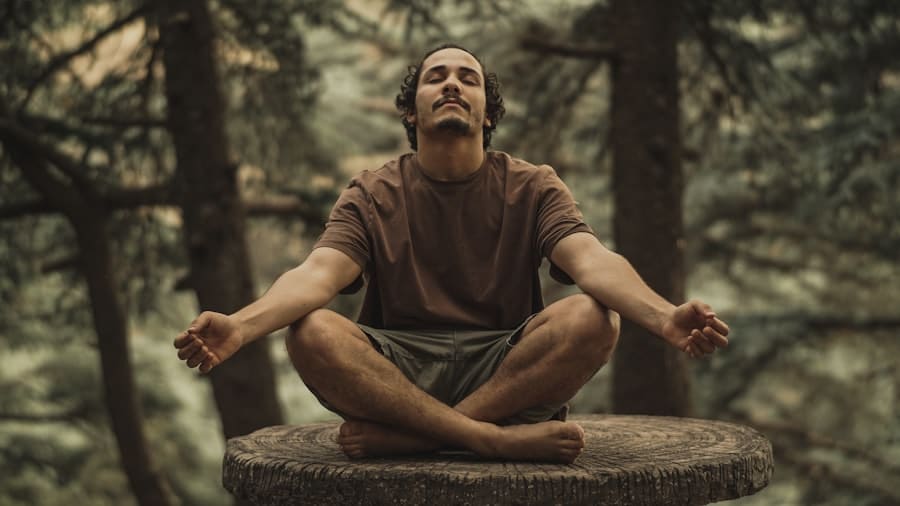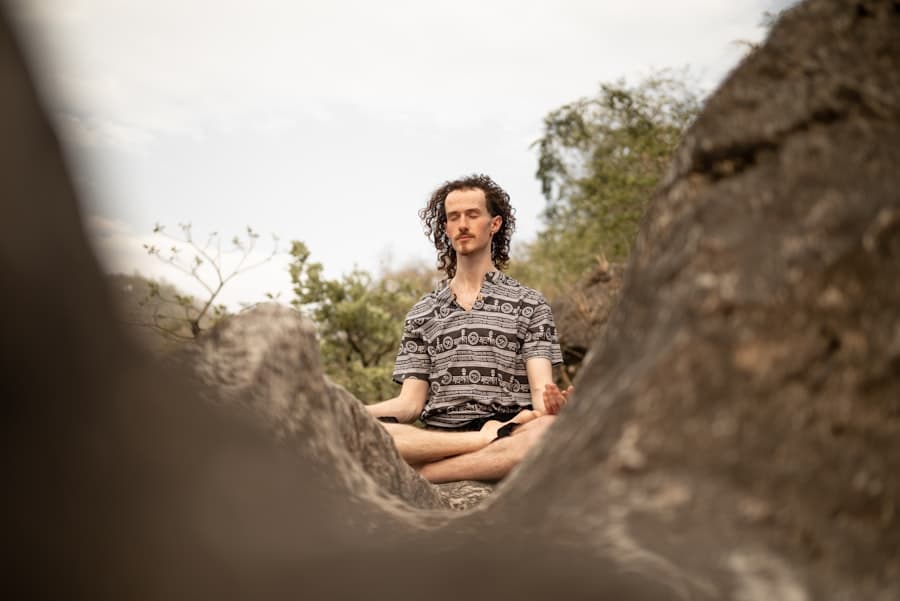In recent years, the intersection of technology and wellness has given rise to innovative practices that enhance mental health. Among these, virtual reality (VR) meditation spaces have emerged as a groundbreaking development. These immersive environments allow users to engage in meditation practices that transcend the limitations of physical space.
By donning a VR headset, individuals can find themselves in serene landscapes, from tranquil beaches to lush forests, all designed to facilitate relaxation and mindfulness. This evolution in meditation practice is not merely a trend; it represents a significant shift in how we approach mental well-being in an increasingly digital world. The rise of VR meditation spaces can be attributed to several factors, including the growing awareness of mental health issues and the increasing accessibility of VR technology.
As stress and anxiety levels continue to rise globally, more individuals are seeking effective methods to manage their mental health. Traditional meditation practices, while beneficial, may not resonate with everyone. VR offers a unique solution by providing an engaging and interactive experience that can appeal to a broader audience.
Furthermore, advancements in VR technology have made it more affordable and user-friendly, allowing for widespread adoption among various demographics.
Key Takeaways
- Virtual reality meditation spaces are becoming increasingly popular as a way to escape the distractions of the physical world and immerse oneself in a calming environment.
- VR meditation has been shown to have numerous mental health benefits, including reducing stress and anxiety, improving focus and attention, and promoting overall well-being.
- VR meditation spaces are accessible to people of all ages and abilities, making it easier for individuals to find a quiet and peaceful place to meditate.
- Virtual reality plays a crucial role in creating a calming environment by providing immersive visuals and sounds that can transport users to serene and tranquil settings.
- VR meditation has a significant impact on reducing stress and anxiety, offering a promising alternative for those seeking relief from mental health challenges.
The Benefits of VR Meditation for Mental Health
The benefits of VR meditation for mental health are manifold, with research indicating that immersive experiences can significantly enhance the effectiveness of traditional meditation techniques. One of the primary advantages is the ability to create a fully immersive environment that minimizes distractions. In a world filled with constant notifications and interruptions, finding a quiet space to meditate can be challenging.
VR meditation spaces eliminate these external distractions by transporting users to calming environments where they can focus solely on their practice. Moreover, VR meditation has been shown to improve emotional regulation and reduce symptoms of anxiety and depression. Studies have demonstrated that individuals who engage in VR meditation report lower levels of stress and improved mood compared to those who meditate in traditional settings.
The immersive nature of VR allows users to engage more deeply with their meditation practice, fostering a sense of presence that can lead to profound relaxation and introspection. This heightened engagement can be particularly beneficial for those who struggle with maintaining focus during conventional meditation sessions.
How VR Meditation Spaces are Accessible to All

Accessibility is a crucial consideration in the development of any mental health intervention, and VR meditation spaces are no exception. One of the most significant advantages of VR technology is its potential to reach diverse populations, including those who may not have access to traditional meditation resources. For instance, individuals living in urban areas may find it challenging to locate quiet spaces conducive to meditation.
VR meditation spaces can be accessed from the comfort of one’s home, making it easier for people from various backgrounds to engage in mindfulness practices. Additionally, VR meditation platforms often offer a range of experiences tailored to different skill levels and preferences. Beginners can start with guided meditations that provide step-by-step instructions, while more experienced practitioners can explore advanced techniques or customize their sessions according to their needs.
This flexibility ensures that users can find a practice that resonates with them, regardless of their prior experience with meditation. Furthermore, many VR meditation applications are designed with inclusivity in mind, featuring options for individuals with disabilities or those who may require additional support during their practice.
The Role of VR in Creating a Calming Environment
Creating a calming environment is essential for effective meditation, and VR excels in this area by offering users the ability to choose from a variety of serene settings. Whether it’s a peaceful mountaintop at sunrise or a quiet beach at sunset, these virtual environments are meticulously designed to evoke feelings of tranquility and relaxation. The visual and auditory elements within these spaces work together to create an immersive experience that can transport users away from their daily stresses.
Moreover, the ability to customize these environments enhances the overall experience. Users can select specific sounds—such as gentle waves lapping against the shore or birds chirping in a forest—to accompany their meditation sessions. This personalization allows individuals to curate an experience that resonates with their preferences and enhances their ability to relax.
The combination of stunning visuals and soothing sounds creates an atmosphere conducive to mindfulness, making it easier for users to enter a meditative state.
The Impact of VR Meditation on Stress and Anxiety
The impact of VR meditation on stress and anxiety is profound, with numerous studies highlighting its effectiveness as a therapeutic tool. Research has shown that engaging in regular VR meditation can lead to significant reductions in perceived stress levels. For instance, one study found that participants who practiced VR meditation for just a few weeks reported lower levels of anxiety and improved overall well-being compared to those who did not engage in any form of meditation.
The immersive nature of VR allows users to escape from their immediate surroundings and immerse themselves in a calming experience. This sense of escapism can be particularly beneficial for individuals dealing with high levels of stress or anxiety, as it provides a temporary reprieve from their daily challenges. Additionally, the structured nature of guided VR meditations can help users develop coping strategies for managing stress in real-life situations.
By practicing mindfulness within these virtual environments, individuals can learn techniques that they can apply outside of their sessions, ultimately leading to improved resilience in the face of stressors.
Customizing VR Meditation Experiences for Individual Needs

One of the most compelling aspects of VR meditation is its ability to be customized according to individual needs and preferences.
This level of personalization ensures that each session is relevant and meaningful, allowing individuals to engage more deeply with their meditation practice.
For example, some users may prefer short, focused sessions designed for quick stress relief during a busy day, while others may seek longer sessions aimed at deeper relaxation or self-reflection. Additionally, many VR meditation platforms offer various themes—such as gratitude, compassion, or mindfulness—allowing users to align their practice with their personal goals or emotional states. This customization not only enhances user engagement but also fosters a sense of ownership over one’s mental health journey.
The Future of VR Meditation and Mental Health Treatment
As technology continues to advance, the future of VR meditation holds immense potential for transforming mental health treatment. Researchers are exploring innovative ways to integrate VR into therapeutic practices, potentially revolutionizing how mental health professionals approach treatment. For instance, therapists may use VR environments as part of exposure therapy for individuals dealing with phobias or PTSD, allowing clients to confront their fears in a controlled and safe setting.
Moreover, the scalability of VR technology presents opportunities for widespread implementation in various settings, including schools, workplaces, and healthcare facilities. As awareness grows regarding the importance of mental health and well-being, organizations may begin incorporating VR meditation into their wellness programs as a proactive measure to support employees’ mental health. This shift could lead to a cultural change where mindfulness practices become an integral part of daily life rather than an afterthought.
Overcoming Challenges and Limitations in VR Meditation Spaces
Despite the promising benefits of VR meditation spaces, several challenges and limitations must be addressed for widespread adoption. One significant concern is the potential for motion sickness or discomfort associated with prolonged use of VR headsets. While advancements in technology have reduced these issues for many users, some individuals may still experience discomfort during extended sessions.
Another challenge lies in ensuring equitable access to VR technology across different socioeconomic groups. While prices have decreased over time, not everyone has access to high-quality VR equipment or reliable internet connections necessary for streaming content.
Addressing these disparities will be crucial in making VR meditation accessible to all individuals seeking mental health support. In conclusion, while there are hurdles to overcome, the potential benefits of virtual reality meditation spaces are significant and warrant further exploration and investment. As technology continues to evolve and our understanding of mental health deepens, VR meditation could play an essential role in promoting well-being across diverse populations.
In recent years, the integration of technology into mental health practices has seen significant advancements, particularly with the use of virtual reality (VR) for meditation. This innovative approach is helping individuals manage stress and anxiety by providing immersive environments that promote relaxation and mindfulness. A related article that explores the intersection of technology and creativity is Best Free Software for 3D Modeling in 2023. This piece delves into the tools available for creating 3D models, which can be instrumental in designing the virtual spaces used in VR meditation, highlighting the potential for technology to enhance mental health solutions.
FAQs
What is VR meditation?
VR meditation is a form of meditation that uses virtual reality technology to create immersive and interactive environments for users to practice mindfulness and relaxation.
How do VR meditation spaces promote mental health?
VR meditation spaces promote mental health by providing users with a unique and immersive way to practice meditation, which can help reduce stress, anxiety, and improve overall well-being.
What are the benefits of using VR for meditation?
Some benefits of using VR for meditation include increased immersion and presence, the ability to customize environments to suit individual preferences, and the potential for enhanced relaxation and stress reduction.
Are there any potential drawbacks to using VR for meditation?
Some potential drawbacks of using VR for meditation include the risk of overstimulation, potential discomfort from wearing VR headsets for extended periods, and the need for access to VR technology.
Is VR meditation suitable for everyone?
While VR meditation can be beneficial for many people, it may not be suitable for everyone, especially those who experience motion sickness or discomfort when using VR technology. It’s important to consider individual preferences and needs when exploring VR meditation.

